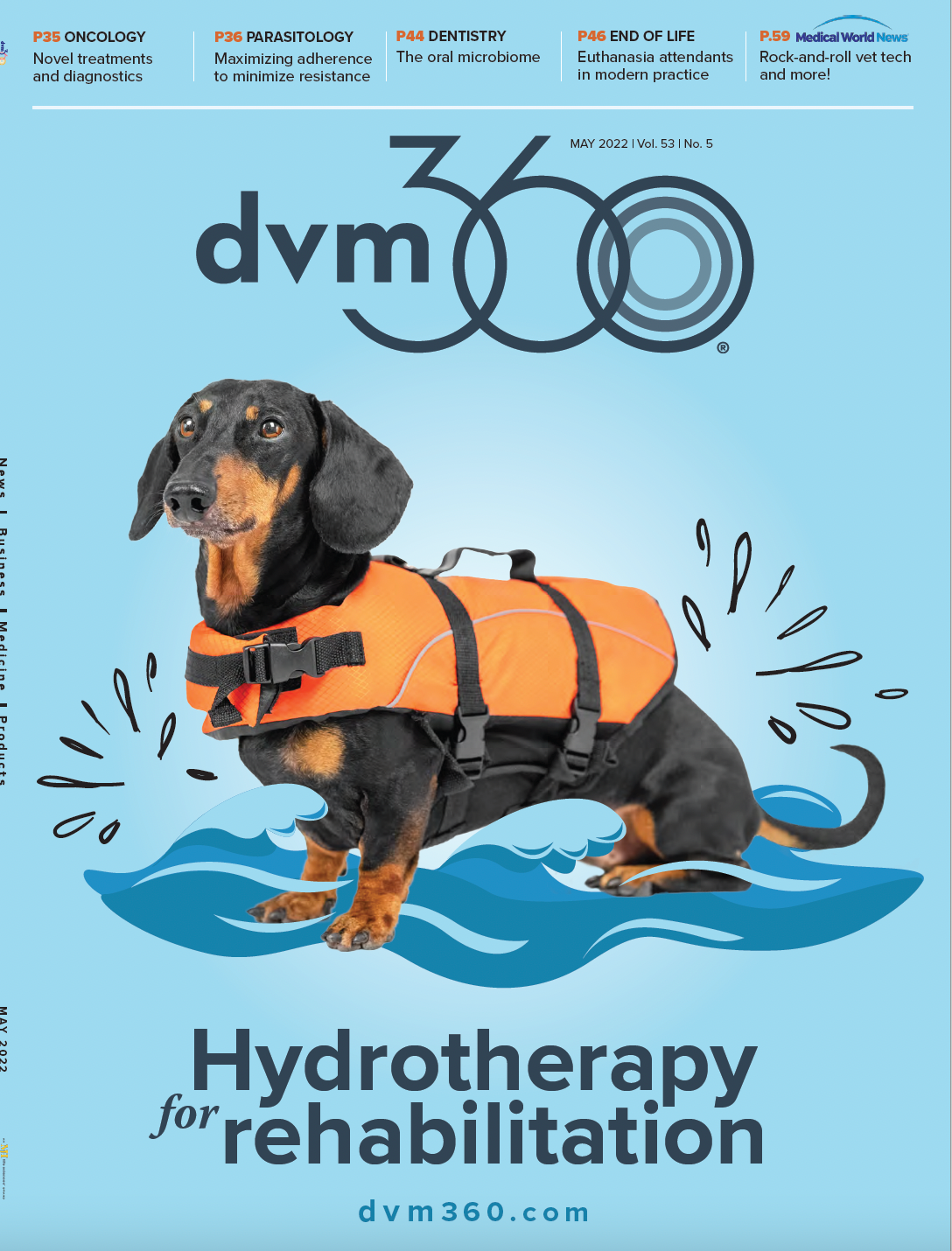Lyme disease risk forecast to increase
The expanding range of the tick vector may contribute to potential cases of infection
Image provided by CAPC

The Companion Animal Parasite Council (CAPC) is warning that vector-borne diseases including Lyme will pose higher-than-average risks across much of the United States this year.1,2
In its 2022 Pet Parasite Forecast, the CAPC reported that tick-borne diseases such as Lyme are further spreading throughout the nation. The CAPC is publishing 30-day Pet Parasite Forecast Maps to alert pet owners of forthcoming outbreaks every month in each US county.1
Growing range for potential disease
Transmitted by ticks, Lyme disease (Borrelia burgdorferi) is spreading because of the expansion of the tick vector (Ixodes scapularis) host habitat range, primarily deer and rodents, and migratory birds carrying ticks to new areas. Warmer weather and longer seasons for tick reproduction are also factors.2
As the tick vector of Lyme disease continues to expand its range, the 2022 Pet Parasite Forecast noted the following geographic trends1,2:
- The geographic prevalence of Lyme disease continues to expand southward and westward.
- CAPC expects increases beyond last year’s forecasts in eastern Kentucky, northeastern Tennessee, western Michigan, and Ohio.
- High-risk “hot spots” are again predicted in northern and western lower Michigan and southern and northeastern Ohio.
- High risks of Lyme disease persist in all portions of the Northeast, the upper Midwestern states of Wisconsin and Minnesota, and the upper peninsula of Michigan. Additionally, a higher-than-normal risk continues in North Dakota, northeastern South Dakota, Iowa, Illinois, and eastern Kentucky.
The southward movement of Lyme disease is also evident in the increasing risk in the Carolinas and Tennessee. Higher risk areas in east central South Carolina and most of coastal North Carolina appear for the first time in the 2022 forecast.1,2 According to CAPC, these emerging threats validate and emphasize CAPC reminders that pets and pet owners do not have to travel to the traditional endemic areas of the Northeast to encounter substantial Lyme disease risks.1
Prevention and treatment
“Because of the zoonotic potential of parasites, we started providing our annual forecasts to alert communities to the risk they pose to people and pets locally. Over the years, we’ve seen the risk for parasitic diseases increase and expand into areas that have had historically lower prevalence,” Christopher Carpenter, DVM, and chief executive officer of CAPC, said in an organizational news release.1
The 2022 forecast also spotlights areas where more action should be taken to reduce the risk of companion animals’ exposure to disease vectors. The core of these prevention strategies includes veterinarians suggesting that pet parents annually test their pets for disease and protect them with products that kill or repel mosquitos and ticks, plus receive year- round heartworm prevention.1 According to CAPC, veterinarians and pet owners should also test pets annually and use tick preventives year-round. A vaccination for Lyme disease should always be considered for pets in high-risk areas.2
“CAPC’s 2022 Pet Parasite Forecast is critical to alerting pet owners to the risks this year and reinforcing CAPC’s recommendation that all pets need to be annually tested and protected year-round,” Carpenter said in the release.1
Novel therapeutic options
Pharmaceutical treatments can also help to prevent and control tick infestations in dogs and cats that can lead to Lyme disease. Recent FDA approvals have allowed promising new therapies to arrive on the market.
In January 2022, the FDA approved a label expansion for sarolaner, moxidectin, and pyrantel chewable tablets (Simparica Trio; Zoetis) to include indication for the prevention of Borrelia burgdorferi infections in dogs aged 8 weeks and older weighing at least 2.8 lb. According to Zoetis, the medication is the first combination product demonstrated to prevent infections that may cause Lyme disease. This treatment works by killing Ixodes scapularis vector ticks, including black-legged or deer ticks, which can transmit the infection.3
“Once dogs are infected with Borrelia burgdorferi, the bacteria’s unique mode of motility allows it to rapidly disseminate throughout the body. This can make the infection difficult to treat,” Richard T. Marconi, PhD, an expert in microbiology and immunology at Virginia Commonwealth University Medical Center and a consultant for Zoetis, said in an organizational news release.3
For cats aged 6 months and older and weighing 2 lb or greater, lotilaner (Credelio Cat; Elanco Animal Health) is indicated for treatment and control against Ixodes scapularis infestation. The FDA-approved prescription oral
tick treatment is administered monthly. Designed specifically for cats, the therapy offers a vanilla and yeast scent and flavor that appeals to many feline patients, according to Elanco. In a field study, these lotilaner chewables were successfully administered by 99.5% of participating cat owners.4
Elanco Animal Health also offers a lotilaner chewable product for dogs, Credelio, for treatment and control of tick infestations including Ixodes scapularis. This drug treatment is indicated for all dogs aged 8 weeks and older and weighing 4.4 lb or greater.5
Conclusion
In regions of historically high prevalence and in forecast regions of increased risk, the CAPC suggests that veterinarians reinforce recommendations of aggressive tick control and advise pet owners about the importance of year-round prevention. Lyme disease has the potential to spread anywhere the tick vector is present and vaccination should be considered for high-risk patients.1
References
- CompanionAnimalParasiteCouncilreleases2022annual
Pet Parasite Forecast. News release. Companion Animal Parasite Council. February 27, 2022. Accessed April 26, 2022. https://www.prweb.com/releases/companion_animal_para- site_council_releases_2022_annual_pet_parasite_forecast/ prweb18523358.htm - Companion Animal Parasite Council. Risk of exposure
to vector-borne pathogens: what to expect this year. Capcvet.org. Accessed April 26, 2022. https://capcvet.org/ articles/2022-forecasts - FDA approves expanded indication for sarolaner, moxidectin, and pyrantel chewable tablets. dvm360®. January 4, 2022. Accessed April 25, 2022. https://www.dvm360.com/view/ fda-approves-expanded-indication-for-sarolaner-moxidec- tin-and-pyrantel-chewable-tablets
- Elanco Animal Health introduces first oral flea and tick product for cats, Credelio Cat (lotilaner). News release. May 4, 2021. Accessed April 28, 2022. https://investor.elanco.com/ press-releases/press-releases-details/2021/Elanco-Animal- Health-Introduces-First-Oral-Flea-and-Tick-Product-for-Cats- Credelio-CAT-lotilaner/default.aspx
- Dogs: Credelio (lotilaner). Elanco Animal Health. Accessed April 28, 2022. https://www.elanco.us/products-services/ dogs/credelio
